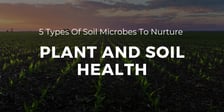By Kaitlyn Ersek on Oct 5, 2017 6:00:00 AM
.png?width=1024&name=Blog%20headers%20%232%20(5).png)
“My favorite nematodes are pathogenic Melodogvne (root-knot nematodes) and Heterodera (soybean cyst nematodes),” admits Dr. Kris Nicholas Lambert from the University of Illinois at Urbana-Champaign.
It may sound strange to name favorite pathogenic nematodes, especially considering that nematodes represent a $100 billion problem in terms of worldwide plant loss, but for a long-term nematode enthusiast like Dr. Lambert, naming favorites is just second nature.
While pursuing his doctorate in molecular biology and biochemistry at the University of California, Davis, Dr. Lambert was introduced to Davis’s Department of Nematology (now referred to as the Department of Entomology). He has since become one of the foremost authorities on pathogenic nematodes in America and has lovingly devoted his career to the study of controlling and understanding how pathogenic nematodes operate. Today, he is a researcher and associate professor at the University of Illinois at Urbana-Champaign.
“When it comes to studying products and their effect on nematodes, you’re lucky if you can persuade Dr. Lambert to take you on,” explains Holganix’s President of Agriculture, Dr. David Stark. “That’s why we were excited when Dr. Lambert agreed to study a specific Holganix technology and its effect on pathogenic nematodes including the root-knot and the soybean cyst nematode.
While studies are still ongoing, preliminary results have shown a 75% reduction in pathogenic nematodes with Holganix technology in a lab setting and an 80% reduction in pathogenic nematodes in a field setting.
Why Study Nematodes?
Pathogenic nematodes may be small microscopic roundworms, but they represent a BIG problem for growers and turf professionals. In fact, according to a study published by the Society of Nematologists, pathogenic nematodes are responsible for an estimated 14% loss of all economically important crops worldwide, translating to over $100 billion annually.
Pathogenic nematodes feed on plant roots, damaging them and draining nutrients from the plant, decrease yields and increase the plant’s susceptibility to other stresses.
Growers and turf professionals suffering from nematode infestations on their fields are often faced with two options:
- Pay a small fortune to decimate all biology within the soil via a toxic nematicide
- Ignore the problem, and deal with the consequences.
Watch the video below for a visual of a root-knot nematode entering a melon root.
In 2015, golf courses in Florida began taking notice and talking about results they saw on pathogenic nematodes while using Holganix Bio 800+ Golf.
Shannon Easter, the Director of Golf Maintenance and Environmental Consultant for Broken Sound Golf Club in Boca Raton, Florida, saw an average 60% decrease in pathogenic nematode counts and attributes the results to Holganix Golf.
>>Read about Shannon’s case study here
Results on Florida golf courses inspired Holganix scientists to dig deeper and invest in research to better understand the benefits of Holganix technology on pathogenic nematodes.
Digging into the Results
While research is still ongoing, preliminary results conducted in a lab setting by Dr. Lambert at the University of Illinois are promising. After the first year of studying the product, the team saw a 75% reduction in pathogenic nematodes in the lab.
“It’s complex,” explains Dr. Lambert of Holganix technology. “There’s a lot of things going on in the jug and it is difficult to state with certainty why Holganix technology is producing results.” However, Dr. Lambert does have three theories.
1. Affecting migration to the roots - Holganix technology appears to confuse or incapacitates the nematode so it can’t migrate to the plant and cause harm.
2. Inhibiting eggs from hatching - Holganix technology may be inhibiting soybean cyst nematode eggs from hatching.
3. Targeting pathogenic nematodes - Microbes in Holganix technology may be attacking pathogenic nematodes.
“We are taking a two-pronged approach to study Holganix technology,” explains Dr. Lambert. “In 2016, we studied Holganix technology in a lab. This year, we are continuing lab testing but we are also studying it in the field.”
So far, field tests have also been promising. After inoculating each crop with pathogenic nematodes and applying Holganix technology, Dr. Lambert reports an 80% reduction in pathogenic nematodes.
Dr. Lambert will need to repeat the lab studies two or three times and the field studies over a minimum of two growing seasons before drawing conclusive results regarding the effect, mechanism, and application of Holganix technology when used as a treatment against pathogenic nematodes.
What will the future hold?
Dr. Lambert continues to diligently test Holganix technology against pathogenic nematodes and hopes to write a paper about the subject in the near future. At the end of the day, “chemical treatments (nematicides) are extremely expensive for growers and turf professionals,” explains Dr. Lambert. “The fact that Holganix technology is better for the environment, technician, and pocket-book is exciting. We are crossing our fingers and hoping for additional positive feedback. Stay tuned!”
Today, Holganix does not offer a registered nematicide product and results on Holganix technology’s influence over pathogenic nematodes are still pending; however, the Holganix team is excited by the results and what those results could mean for the future of Holganix.
Dig Into The Data: University And Commercial Grower Trials
Over the years, we have compiled data on several different crops, in different geographic zones, to deepen our understanding of how Holganix Bio 800+ can help farmers maximize crops. Click the button below to access a sample from our 2017 - 2020 collection.















